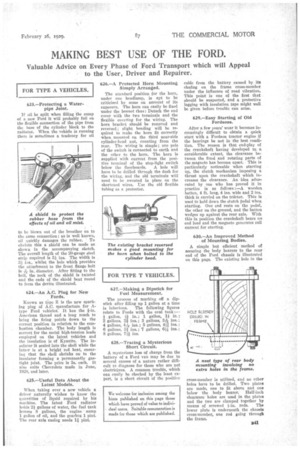MAKING BEST USE OF THE FORD.
Page 67

If you've noticed an error in this article please click here to report it so we can fix it.
Valuable Advice on Every Phase of Ford Transport which will Appeal to the User, Driver and Repairer.
FOR TYPE A VEHICLES. I 623.—Protecting a Waterpipe Joint.
If oil be spilt when filling the sump of a new Ford it will probably fall on the flexible connection of the pipe from the base of the cylinder block to the radiator. When the vehicle is running there is sometimes a tendency for oil to be blown out of the breather on to the same connection: as is well known, oil quickly damages the rubber. To obviate this a shield can be made as shown in the accompanying sketch. The overall length of the 20-gauge steel strip required is 5-b, ins. The width is 3i ins., whilst the hole which provides the attachment to the front flange bolt is in.. diameter. After fitting to the bolt, the neck of the shield is twisted and the ends of the shield bent round to form the device illustrated.
624.—An A.C. Plug for New Fords.
Known as type Z is the new sparking plug of A.C. manufacture for Atype Ford vehicles It has the Fin. American thread and a long reach to bring the firing points down to the correct position in relation to the combustion chamber. The body length is correct for the metal high-tension leads employed on the latest vehicles and the insulation is Of Kyanite. The insulator ili sealed into the shell while the latter is at a bright red heat, ensuring that the shell shrinks on to the insulator forming a permanently gastight joint. The price is 5s. each. It also suits Chevrolets made in June, 1928, and later.
625.—Useful Data About the Latest Models.
When taking over a new vehicle a driver naturally wishes to know the quantities of liquid required by his machine. The latest Ford radiator holds 2i gallons of water, the fuel tank houses 8 gallons, the engine sump 1 gallon of oil, and the gearbox 1 pint The rear axle casing needs 11 pint 626.—A Protected Horn Mounting Simply Arranged.
The standard position for the horn, under one headlamp, is apt to be criticized by some on account of its exposure. The horn can easily be fixed under the bonnet thus: Detach the end cover with the two terminals and the flexible covering for the wiring. The horn bracket should be removed and reversed ; slight bending will be required to make the horn fit correctly when mounted on the third near-side cylinder-head nut, counting from the rear. The wiring is simple ; one pole of the switch is connected to earth and the other to the horn. The horn is supplied with current from the positive terminal of the stop-light switch below the floorboards. A hole will have to be drilled through the dash for the wiring, and the old terminals will need to be sweated in place on the shortened wires. Use the old flexible tubing as a protector.
The existing bracket reversed makes a good mounting for the horn when bolted to the cylinder head.
IFOR TYPE T VEHICLES.
627.—Making a Dipstick for Fuel Measurement.
The process of marking off a dipstick after filling up 1 gallon at a time
is laborious. The following figures relate to Fords with the oval tank :•-• • gallon, 1-8in.; 1 gallon, 1-} in.; 2 gallons, 24 ins.; 3 gallons, 3-4ins.; 4 gallons, 4elg ins.; 5 gallons, 4-r6 ins.; 6 gallons, 51 ins.; 7 gallons, etk ins.; 8 gallons, 7-Ft ins.
628.—Tracing a Mysterious Short Circuit.
A mysterious loss of charge from the battery of a Ford van may be due to several causes of a nature rather difficult to diagnose for those who are not electricians. A common trouble, which can easily he checked by the least expert, is a short circuit of the positive cable from the battery caused by its chafing on the frame cross-member under the influence of road vibration. This point is one of the first that should be suspected, and a protective lagging with insulation tape might well be given before trouble can arise.
629.—Easy Starting of Old Fordsons.
After a few years' wear it becomes increasingly difficult to obtain a quick start with a Fordson tractor engine if the bearings be not in the best eondition. The reason is that end-play of the crankshaft having developed to a considerable extent, the clearance between the fixed and rotating parts of the magneto has become upset. This is Particularly noticeable when starting up, the clutch mechanism imposing a thrust upon the crankshaft which increases the clearance. An idea advocated by one who has proved it in practice is as follows :—A wooden batten, 4 ft. tong, 4 ins, wide and 2 ins. thick is carried on the tractor. This is used to hold down the clutch Pedid when starting. One end rests on the pedal, the other on the ground, and the batten wedges up against the rear axle. With this in position the crankshaft bears no end load and the magneto generates tull current for starting.
630.—An Improved Method of Mounting Bodies.
A simple but efficient method of securing the body bearers to the rear end of the Ford chassis is illustrated on this page. The existing hole in the cross-member is utilized, and no other holes have to be drilled. Two plates are made, one to fit above and one below the body bearer. Half-inch clearance holes are used in the plates and the two are clamped together by means of screwed i-in. rods. The lower plate is underneath the chassis cross-member, one rod going through the frame.




















































































































